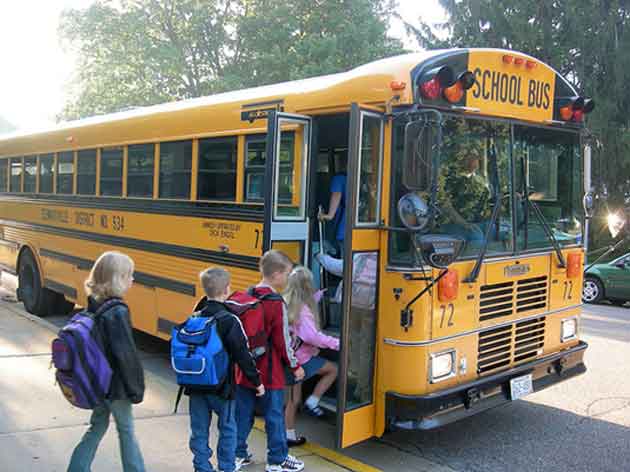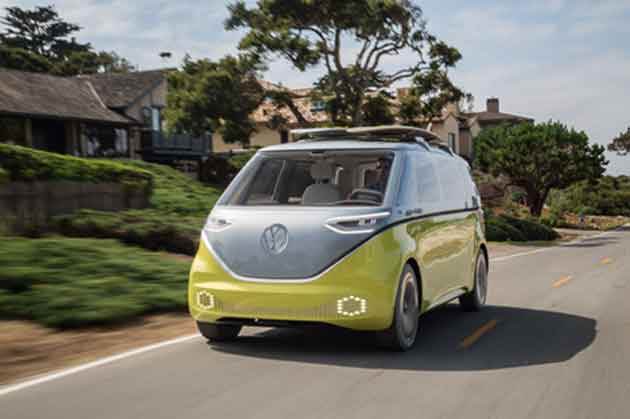| -- | August 29, 2017 Why Super-Efficient School Bus Routes Could Wreck the US Economy By Patrick Watson Everyone is worried about robots. Elon Musk fears they will kill us all if we give them both deadly weapons and autonomy. He certainly has a point, but the non-lethal scenarios are no picnic either. Robots are already taking over human jobs at a rapid pace. Any work involving predictable, repetitive activities is vulnerable. Worse, artificial intelligence (AI) systems threaten even “knowledge worker” jobs now. This is a troubling combination. What happens when those two get together? Answer: the problem grows exponentially. To see how, consider the humble school bus. 
Image: Ty Hatch via Flickr Fewer Miles = Fewer Drivers There’s a classic math exercise called the Traveling Salesman Problem. The goal: find the shortest path through a series of cities before getting back to where you started. Sounds simple, but it’s maddeningly complex. Even a short itinerary can have millions of possible routes. Finding the fastest one is hard. Local school officials in Boston recently realized that this problem was costing them big money: to be precise, a whopping $120 million a year to transport students. Looking to save money, the school system offered a $15,000 prize to whoever could figure out the most efficient bus route map. Two doctoral students at nearby MIT won the contest. The algorithm they designed eliminated 75 bus routes while still delivering all the students. It will save the school system $5 million a year—a whale of a return on $15,000 invested. Part of that windfall comes from reducing bus driver positions. The new scheme saves a million bus miles per year, and fewer miles means fewer drivers. Note how this works. Boston doesn’t need fancy new self-driving buses to cut bus driver jobs. The routing algorithm doesn’t just replace jobs; it eliminates them. Having done so in Boston, it can now do the same in other places. Even the bus drivers who keep their jobs may not be safe for long. 
Photo: Volkswagen Multiplier Effect Remember the old VW micro-buses? Volkswagen said this month it’s bringing the concept back with a new, all-electric version called the I.D. BUZZ. You’ll be able to buy one in 2022. Aside from being battery-powered, the I.D. BUZZ will also have autonomous driving capability. Volkswagen intends to make a cargo version. They think it will be ideal for delivering small packages in urban areas. If it can deliver packages, it can also deliver public-school students, or anyone else who needs to get from point A to point B… and it won’t need a driver. Tesla, Uber, Google, and others are developing similar driverless vehicles, which will be ready in the next few years. Any job that involves driving will be vulnerable—and not just passenger vehicles. Tesla founder Elon Musk tweeted this back in April:  Musk sometimes gets dreamy on his predictions, but this one may be real. Earlier this month, Reuters obtained emails between Tesla and Nevada state officials. Tesla wants permission to test autonomous electric trucks on Nevada’s highways. As part of the test, the autonomous trucks will move in a “platoon” formation, with one truck following only inches behind the next. Human drivers could never do that safely, but computers can. It also saves battery power by reducing drag. Now, add these two together: - First, advanced algorithms are making transport routes more efficient, reducing the number of vehicles and drivers.
- Second, the remaining vehicles are gaining the ability to drive themselves.
The first part is happening right now—with school buses, delivery routes, and more. It doesn’t need any new technology or permission from regulators. The second part is coming fast. According to Reuters, Tesla wants to test the trucks without a human backup driver aboard, which suggests they may be further along than most observers thought. Either development by itself would do away with hundreds of thousands of human jobs. Together, they have a multiplier effect that could speed up the process considerably. Millions at Risk How many jobs precisely are we talking about? The US has 1.8 million heavy truck and tractor-trailer drivers, according to a new Richmond Fed report. Add the 685,000 bus drivers, the 859,000 local delivery drivers, the 189,000 taxi and 160,000 Uber drivers, and multiple millions are at risk. We have seen such technological revolutions before. One example is bank tellers and ATM machines. There was a lot of fear when ATMs appeared in the 1970s, but they turned out not to kill jobs at all. Instead of just handling cash, tellers became customer service agents, helping the banks sell more services. Something similar might happen for bus and truck drivers. Or the drivers might stay in the loop. Think about airliners. The computerized autopilots can do almost everything from takeoff to landing, yet planes still have human pilots aboard. Why? Because we trust the technology… but not completely. We won’t know until a few years from now which direction this development will take. One thing I’m sure of, though: once these capabilities exist, they won’t disappear. People and businesses will find ways to use them. Critical Mass These potential job losses are both an economic and a social problem. Given time, the economy will sort it out, but meanwhile people will experience real pain—and political leaders will have to find appropriate responses. As an investment matter, automation and robotics is reaching a kind of critical mass. In our analysis for Macro Growth & Income Alert, my co-editor Robert Ross and I have long stopped asking whether machines can do all these things and started wondering how it will work and how to profit from it. A good place to begin is with the two ETFs that cover this sector: - Global X Robotics & Artificial Intelligence Thematic ETF (BOTZ)
- Robo Global Robotics and Automation Index ETF (ROBO)
ROBO launched in October 2013, and BOTZ came out in September 2016. Both are up more than 30% since the later one’s inception.  The AI/robot revolution is still in its infancy, so I think more gains will come. More volatility too. The ETFs are an easy way to get broad exposure whereas buying individual stocks lets you fine-tune the risks to fit your personal goals. We’ve been following this theme in Macro Growth & Income Alert for a while now, using both stocks and options. Selling put options generates current income for our subscribers, since many growth stocks don’t pay dividends. However, investing isn’t always about growth or income. Sometimes it’s about survival. If automation threatens your job, having your portfolio benefit from it may help hedge your career risk. See you at the top,  Patrick Watson P.S. If you’re reading this because someone shared it with you, click here to get your own free Connecting the Dots subscription. You can also follow me on Twitter: @PatrickW.  | Subscribe to Connecting the Dots—and Get a Glimpse of the Future
We live in an era of rapid change… and only those who see and understand the shifting market, economic, and political trends can make wise investment decisions. Macroeconomic forecaster Patrick Watson spots the trends and spells what they mean every week in the free e-letter, Connecting the Dots. Subscribe now for his seasoned insight into the surprising forces driving global markets. |
 Senior Economic Analyst Patrick Watson is a master in connecting the dots and finding out where budding trends are leading. Patrick is the editor of Mauldin Economics’ high-yield income letter, Yield Shark, and co-editor of the premium alert service, Macro Growth & Income Alert. You can also follow him on Twitter (@PatrickW) to see his commentary on current events. Senior Economic Analyst Patrick Watson is a master in connecting the dots and finding out where budding trends are leading. Patrick is the editor of Mauldin Economics’ high-yield income letter, Yield Shark, and co-editor of the premium alert service, Macro Growth & Income Alert. You can also follow him on Twitter (@PatrickW) to see his commentary on current events.
Share Your Thoughts on This Article

Use of this content, the Mauldin Economics website, and related sites and applications is provided under the Mauldin Economics Terms & Conditions of Use. Unauthorized Disclosure Prohibited The information provided in this publication is private, privileged, and confidential information, licensed for your sole individual use as a subscriber. Mauldin Economics reserves all rights to the content of this publication and related materials. Forwarding, copying, disseminating, or distributing this report in whole or in part, including substantial quotation of any portion the publication or any release of specific investment recommendations, is strictly prohibited.
Participation in such activity is grounds for immediate termination of all subscriptions of registered subscribers deemed to be involved at Mauldin Economics’ sole discretion, may violate the copyright laws of the United States, and may subject the violator to legal prosecution. Mauldin Economics reserves the right to monitor the use of this publication without disclosure by any electronic means it deems necessary and may change those means without notice at any time. If you have received this publication and are not the intended subscriber, please contact service@mauldineconomics.com. Disclaimers The Mauldin Economics website, Yield Shark, Thoughts from the Frontline, Patrick Cox’s Tech Digest, Outside the Box, Over My Shoulder, World Money Analyst, Street Freak, Just One Trade, Transformational Technology Alert, Rational Bear, The 10th Man, Connecting the Dots, This Week in Geopolitics, Stray Reflections, and Conversations are published by Mauldin Economics, LLC. Information contained in such publications is obtained from sources believed to be reliable, but its accuracy cannot be guaranteed. The information contained in such publications is not intended to constitute individual investment advice and is not designed to meet your personal financial situation. The opinions expressed in such publications are those of the publisher and are subject to change without notice. The information in such publications may become outdated and there is no obligation to update any such information. You are advised to discuss with your financial advisers your investment options and whether any investment is suitable for your specific needs prior to making any investments.
John Mauldin, Mauldin Economics, LLC and other entities in which he has an interest, employees, officers, family, and associates may from time to time have positions in the securities or commodities covered in these publications or web site. Corporate policies are in effect that attempt to avoid potential conflicts of interest and resolve conflicts of interest that do arise in a timely fashion.
Mauldin Economics, LLC reserves the right to cancel any subscription at any time, and if it does so it will promptly refund to the subscriber the amount of the subscription payment previously received relating to the remaining subscription period. Cancellation of a subscription may result from any unauthorized use or reproduction or rebroadcast of any Mauldin Economics publication or website, any infringement or misappropriation of Mauldin Economics, LLC’s proprietary rights, or any other reason determined in the sole discretion of Mauldin Economics, LLC. Affiliate Notice Mauldin Economics has affiliate agreements in place that may include fee sharing. If you have a website or newsletter and would like to be considered for inclusion in the Mauldin Economics affiliate program, please go to http://affiliates.ggcpublishing.com/. Likewise, from time to time Mauldin Economics may engage in affiliate programs offered by other companies, though corporate policy firmly dictates that such agreements will have no influence on any product or service recommendations, nor alter the pricing that would otherwise be available in absence of such an agreement. As always, it is important that you do your own due diligence before transacting any business with any firm, for any product or service. © Copyright 2017 Mauldin Economics | -- |
